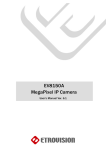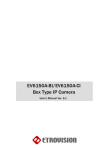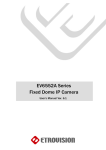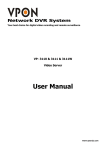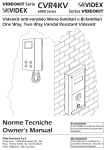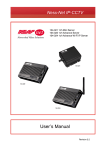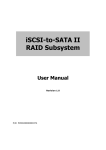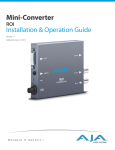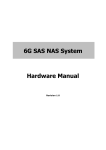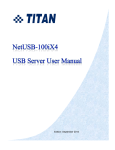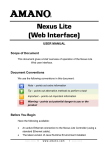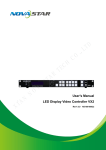Download User`s Manual
Transcript
User Manual Video Server Model No.: SP5711HD, SP5711HDA http://www.micronet.info 3 3 About This Guide Model z SP5711HD Video Server z SP5711HDA Video Server Before Using the Video Server 9 Check PC requirement 9 Check OS platform requirement 9 Read special and important precautionary information. 9 Basic knowledge of network setup and configuration will be helpful. Icon Descriptions Notes: This icon represents a tip for operation. Caution: This icon stands for an action that probably impairs the operation. Warning: This icon stands for a hazard that can cause damage to the operation. 3 04 4 TABLE OF CONTENTS 04 1. PRODUCT OVERVIEW .....................................................................................5 Æ SP5711HD ......................................................................................................6 Æ SP5711HDA ....................................................................................................6 2. SETTING AND INSTALLATION ........................................................................8 3. USING THE VIDEO SERVER FOR THE FIRST TIME .........................................10 4. ACCESS VIDEO SERVER ................................................................................13 5. WEB INTERFACE SETTINGS ..........................................................................17 6. WEB INTERFACE SETTINGS - EXPERT ...........................................................33 6. FACTORY DEFAULT .......................................................................................46 7. REBOOT........................................................................................................46 8. LOGOUT........................................................................................................47 TROUBLESHOOTING .........................................................................................52 SPECIFICATIONS(SP5711HD) ..........................................................................53 SPECIFICATIONS(SP5711HDA)........................................................................55 APPENDIX ........................................................................................................57 4 5 04 1. PRODUCT OVERVIEW SP5711HD/SP5711HDA supports dual streams simultaneously. Combination options include: Stream 1 Stream 2 H.264 H.264 H.264 M-JPEG H.264 MPEG-4 Note: If users assign MPEG-4 for both Stream 1 and 2, the image will be unable to reach real-time performance. M-JPEG for both Stream 1 and 2 leads to the same result. This is system limitation. Differences between SP5711HD and SP5711HDA: Features SP5711HD SP5711HDA Video In ● ● Audio In ● Audio Out ● PTZ ● ● DI / DO ● Wireless Socket ● Package Checklist 9 Video server X 1 9 Power adapter X 1 5 6 9 USB cable X 1 9 Product CD X 1 9 Terminal block connector X 1 (SP5711HD ONLY) 9 Mini DIN cable (SP5711HDA ONLY) 04 Connectors Æ SP5711HD 1 2 3 4. Video In Connector 5. RS-485 PTZ Camera Control 6. Power LED & USB LED 4 5 6 1. 12V DC Power 2. RJ-45 Ethernet Port 3. Config Port Æ SP5711HDA 1. 2. 3. 4. 1 2 3 4 Audio Line In / Audio Line Out BNC Video Input Mini-Din I/O Soclet Power LED 5. 6. 7. 8. 6 5 6 7 8 Config Port USB Host for WiFi Support RJ-45 Ethernet Port 12V DC Power 7 04 PIN Define Note: There is no Mini DIN cable in the package of SP5711HD. The functions of mini Din cable include: 9 Two lines support Digital Input 9 Two lines support Digital Output 9 Two lines support RS485 interface - Blue line : RS485 + - Yellow line : DI + - Black line : DI - Green line : RS485 - Brown line : DO + - Red line : DO – 7 8 04 2. SETTING AND INSTALLATION Note: Connect SP5711HD / SP5711HDA to your network by using a standard Cat-5 cable. Connect the video output of your camera with video in of video server, using standard 75Ω coaxial cable with BNC type connector. Connect speaker and active microphone to Audio Out/In. Product CD Product CD in the package contains: 9 NVR management software o 36CH Live View / Recording / 4CH Playback 9 User’s Manual 9 IP Scan Utility Software POWER ON VIDEO SERVER Use the power adapter, provided in the package, to power on the video server. The adapter should be connected to 110v-220v AC socket. CONNECT TO NETWORK Connect the video server and the network hub/switch via a standard CAT5 Ethernet cable and RJ45 socket. Please pay attention that the PC must be on the same network domain with the video server. CONNECT TO ANALOG CAMERA Connect the video server and the analog camera (CCTV) via a BNC cable. 8 9 04 CONNECT I/O Users have to make pin-to-pin correctly to enable this function. Enable Audio Function (SP5711HDA only) The video flicker may occur when enabling or disenabling audio in and audio out. The situation normally lasts for a second. Pan/Tilt/Zoom Control Preset: set preset point stands for setting. Users may set the amount of preset number. stands for going. Users may set the starting point and the terminal one. The camera will cruise from the starting point to the terminal one once. Focus: Users can adjust the camera focus. Zoom: Users can control the camera zoom ratio. Iris: Users can adjust the camera IRIS level. 9 10 04 3. USING THE VIDEO SERVER FOR THE FIRST TIME BEFORE YOU INSTALL SOFTWARE 9 Please check PC OS platform. Microsoft Windows 2000 or Windows XP is capable of 9 PLEASE read NVR Software user’s manual before installation. LANGUAGE SUPPORT 9 ENGLISH BROWSER for Live Viewing and Video Settings Microsoft IE browser version 6 or higher is recommended. Currently Mozilla Firefox and others are not compatible. FACTORY SETTING - INITIAL IP ADDRESS Default IP Address: 192.168.1.2 Gateway: 192.168.1.1 Subnet Mask: 255.255.255.0 NETWORK DOMAIN Alter the IP address of the PC to the same domain of default value (192.168.1.2). You may alter the IP address of the video server to the same of PC via NVR Software. Please refer to page 45 to check detailed information. USE IP Scan Utility Software The software allows users easily and quickly find the specific video server on the network. Run setup and install the utility. 10 11 04 Select IP Scan from the start menu. User can see the following image: Press Scan button to check the IP and MAC address list. Press Clear Table button and press Scan again to refresh. You will find the list of IP and MAC address listed. To identify your SP5711HD / SP5711HDA you can flip over the video server and on the bottom side you check the label for MAC address. Note Please pay attention that a completed RMA form must contain the serial number of the product. CHANGE NETWORK SETTING via IP Scan Utility Double click on a specific IP address; the setting page will pop out. Users may 11 12 alter some basic network parameters in this page. 04 Be sure to press Apply to enable the new setting Within 10 seconds, the dialog box would disappear. This indicates that the new settings are deployed. After typing in the new IP address, user may close the setting page and wait for 45 seconds. It takes 45 seconds to restart the system. After rebooting, user may press Scan to check the new IP address. Note “DOUBLE RIGHT CLICK” Function Double right click on a specific IP address on the list; user can quickly open the live viewing page. Press Exit to quit. 12 browser 13 04 4. ACCESS VIDEO SERVER BROWSER ¾ Open an IE browser ¾ Type in the IP address of video server that you found via IP Scan Utility For example : 192.168.1.2 (default IP address) ¾ A popup login dialog box will automatically display. ¾ Initial username and password (case-sensitive) : Login: root Password: pass Press OK button to access to the live viewing web page. 13 14 INITIAL USERNAME & PASSWORD 04 Æ Administrator ¾ Default ID/Password = root/pass. ¾ The ID of administrator can not be changed or deleted; only the password is changeable. ¾ Administrator has the authority to view and control system settings. After logging in with root/pass as administrator, user may see the live viewing page. SP5711HD/SP5711HDA Live Viewing Page (Admin Mode) 1/2 4 3 14 15 04 1. There is a toggle button on the top right corner of the live viewing page. 2. User may press this button to switch web configuration page to the live viewing page and vice versa. 3. Control options are listed on the right side. 4. OSD is displayed on top left corner of the screen. The sequence is date (mm-dd-yyyy), time, and camera name. (camera name is optionally displayed) CONTROL PANEL SETTINGS 15 16 04 1. Video\Resolution The following table shows common resolution format values: Resolution CIF QCIF D1 NTSC 352X240 176X120 720X480 PAL 352X288 176X144 720X576 2. Video rates\Bit rates 3. Choose a specific value and the setting will be enabled within few seconds. The image on the screen might briefly pause. 3. Camera Information (Please refer to the picture) The button is on the lower right corner of the live viewing image, showing video information such as frame rate (fps), model name, and resolution. FPS 4. Name Resolution Digital Output (SP5711HDA only) (Please refer to the picture) To enable this function, user has to connect the PIN via the Mini DIN cable. And toggle button works as a switch to enable/disenable Digital Out function. 16 17 04 5. WEB INTERFACE SETTINGS SP5711HD / SP5711HDA built-in web interface provides the access to further settings. Enable the top-right side icon in the live viewing page to access to the further settings. This button also works as a switch between Config and Live viewing page. (Please refer to the picture in p.16) 17 18 04 STATUS 1. Status is the first item of the setting options. 2. This page shows the IP address, MAC address of the video server, hardware, firmware information, and other related information. NETWORK There are three available types of wired network connection: STATIC, DYNAMIC and, PPPoE. 1. STATIC IP 2. IP Address Please confirm with the network administrator. 3. Subnet Mask/Gateway/Default DNS Please confirm with the network administrator. Be sure to press “OK” to save the new setting. 4. Reboot will be required and automatically triggered after pressing OK. Please wait for a moment to the count down timer stop. The page will be 18 19 redirected to the initial login one. 04 Notes: Always use IP Scan™ to find the MAC addresses after reboot and double check the IP address. Make sure the IP address is correct. If IP was changed in web configuration, you cannot return to initial login page after reboot. DYNAMIC IP 1. If DHCP server is on LAN and you want to allocate Dynamic IP address, use DHCP. 2. Press “OK” button. 3. Reboot will be required and automatically triggered after pressing OK. 4. Please wait for a moment to the count down timer stop. The page will be redirected to the initial login one. Note: Always use IP Scan to find the MAC address after reboot and double check the IP address is correct. If IP was changed in web 19 20 configuration, you cannot return to initial login04page after reboot. ÆPPPoE SETTINGS 1. If the network supports PPPoE like xDSL, this option is available. 2. Require ISP(Internet Service Provider) to provide ID/Password 3. User ID / Password 4. PPPoE user ID / Password 5. Service Name: Service name of ISP 5. MTU 。Maximum transmission unit of data 6. IP address of DNS sever can be set to be automatically created. 7. If xDSL does not use static IP, you should use DHCP. 20 21 04 Caution Be sure press “OK” after you have changed the setting in a particular setting page. After few seconds, a confirmation dialog box will pop out to indicate that the setting has been updated. To return to the same page, please press OK. 21 22 04 VIDEO Stream 1 Æ VIDEO SETTINGS 1. Stream Port: Stream 1 port value setting 2. Stream Protocol : Selectable options: TCP/UDP(RTP) / User can decide whether to enable multicast function or not (If UDP is selected). 3. Video Compression Type: Selectable options : H264/M-JEPG / MPEG-4 4. Resolution: Selectable options :D1/CIF /QCIF 5. Bit rate Type: There are two selectable options: constant bit rates (CBR) and variable bit rates (VBR), providing the flexibility in choosing bandwidth. 22 23 6. Constant bit rates (CBR): 4M / 3M / 2M / 1.5M / 1M / 750K 04 / 500K / 384K / 256K / 128K / 64K Note: 1M is recommended when using H.264; 1.5M is recommended when using MPEG-4. Note: When mosaic or fragment occurs in the image, users may lower the frame rate or assign another level of image quality. 7. Variable bit rates (VBR) ranges: 2 ~ 31 (The value “3” is recommended.) 8. Frame per second: 1 / 5 / 10 / 15 / 20 / 25 / 30 8. Group Size (GOP): This function is designed for adjusting the ratio between “I” frame and “P” frame. Lower the group size represents the lower bandwidth consumption. 9. Video Type: NTSC / PAL Note: System can automatically detect the input video signal when the detect icon clicked. Æ MAX CLIENT This function allows more than one user to have the access to the video stream. The relationship between bit rates, resolution, and the client amount is an inverse ratio. 1. Maximum number of clients depends on the available network bandwidth and the required video quality. The available range is 0 ~ 10. 23 24 04 Stream 2 Caution: You have to enable Stream 2 in this section to see the option on the control panel setting page. The setting in stream 1 and 2 are the same. ; Administrator can decide whether to enable this stream or not and see the live video in “Live Viewing” page. 24 25 04 Æ COLOR SETTINGS Users may make some fine adjustments to the video quality. The following is the instruction: 1. BRIGHTNESS: Adjust the brightness of the image. 2. CONTRAST: Adjust the variation in the intensity of an image. 3. SATURATION: Adjust the intensity of color in the image. 4. HUE: Adjust the gradation or variety of a color. 25 26 04 Æ VIDEO PREVIEW This function makes user easily check the possible change of altering parameters or setting. By pressing the View Video button, you can see the following Press Stop to exit preview mode. You could alter other parameters and press TEST to see the expected video image. In the process, user can press Reset anytime to return to the default settings. Press Enable Preview to save the current setting – the new settings will be enabled immediately. 26 27 04 Note: Do not forget to press “OK” button to save the current settings. EVENT RULE SP5711HD/SP5711HDA is capable of handling all basic and standard events. Note: The functions of SP5711HD don’t include D/I and D/O. Æ Events handled by SP5711HD 1. Motion Detection 2. Periodic Timer 3. Network Loss 4. Video Loss 5. Power Loss Æ Actions supported by SP5711HD 1. PTZ Preset 2. E-mail Notification 3. Record (Record to Local SD Card) Æ Events handled by SP5711HDA 1. Digital Input 2. Motion Detection 3. Periodic Timer 4. Network Loss 5. Video Loss 6. Power Loss Æ Actions supported by SP5711HDA 1. Digital Output 2. PTZ Preset 3. E-mail Notification 4. Record (Record to Local SD Card) 27 28 04 Æ EVENTS HANDLED 1. Digital Input: Two options of sensor type: “Normal Open” (N.O.) or “Normal Close” (N.C.) 2. Motion Detection: If motion is detected on the areas defined on the video stream, an event will be triggered. 3. Periodic Timer: In a pre-defined time interval, an event will be triggered as the schedule. For example, if the time interval is 60-second, the event will be triggered once per 60-second. 4. Network Loss: When network loss is detected, an event will be triggered. 5. Video Loss: When Video loss is detected, an event will be triggered. 6. Power Loss: When system power loss is detected, an event will be triggered. 28 29 The e-mail notification which indicates the time interval of power 04 loss will be made as powering on. Æ ACTIONS TRIGGERED 1. Digital Output: Activate digital output. 2. PTZ Preset: PTZ set to a particular preset value can be triggered based on occurrence of an event listed out in “Rule Lists”. 3. E-mail Notification: E-mail can be sent based on occurrence of an event listed out in “Rule Lists”. 4. Record: When event triggered, system will record streaming to FTP Server. Æ RULE LISTS - ADDING/DELETING Select an event and select corresponding action. Press add button and notice that is added in the Rule lists Information box. Æ MODIFYING RULE LISTS User may press Delete All to delete the items of event rules. 29 30 04 DATE & TIME 1. Press the “Client PC time” check box, Date and time setting can be synchronized with PC directly. Press “OK” after you have set. 2. Time zone can be chosen by choosing either of the two time servers listed 3. Either of the two time servers can be chosen to synchronize video server time. They are listed as follows should you choose Time Server. Click “OK” after you have changed settings. 4. If you want to manually input time server, choose “Other” then you can find a manually input edit box. Key in your preferred time server and press 30 31 “OK”. 04 OSD 31 32 04 Note: The OSD and Camera Info. display are independent. If “Enable” checkbox is checked, the channel name will be shown on OSD. If not, this information will be shown on the Camera Info. only. 32 33 04 6. WEB INTERFACE SETTINGS EXPERT Pan/Tilt/Zoom CONTROL 33 34 04 1. Channel Mode (PTZ model) a. The Default setting is none. b. Selectable options include PelcoP / PelcoD / Merit-Lilin / Transparent / Visca /DynaColor. 2. Channel ID a. Define the address value. The default value is zero. 3. Baud rate / Data bits / Parity / Stop bits a. The values of these parameters depend on the enabled protocol. PORT Caution: The default port value is 80. Users may change the value. Please pay attention that if the port is changed (e.g.80), users have to put :80 in the end of the IP address. The values of WEB and AV port can be changed. 34 35 04 1. Web: The default value of Web Port is 80 2. Configuration Port: The default port is 1150. (Contacting with your NVR vendor to check this feature is recommended.) DDNS The function is used to map an IP address with the host name. If the video server is set as a dynamic IP address, the host name must be provided by DDNS (Dynamic Domain Name Service). 1. IPv4 DDNS 35 36 ¾ Check “Enable” and select one from the two options. 04 ¾ Registrations on DDNS service sites are required for the two options. ¾ Please go to dyndns.org for registration and further information. Æ SMTP/FTP SP5711HD / SP5711HDA support e-mail notification & FTP upload 36 37 E-MAIL – SMTP SETTING: Enter the port number, user name, password, and 04 server name information of the SMTP server. If you’d like to receive the attached snapshots, please enable the appropriate check box. Authentication is not a mandatory requirement by SMTP servers. In some situations, the required information includes the SMTP server name and e-mail address only. Note: Users may define the following parameters. 2. FTP SETTING: Please fill in the address of remote FTP server, port number, user name, and password. Caution: Users may assign the port value (e.g.30). Be sure to add: 30 in the end of the IP address to facilitate the operation. 37 38 04 TRIGGER SETUP Caution: The anode of Mini DIN has to be connected to the anode of the device to facilitate the operation. So does the cathode. Three different types of EVENTS can be triggered Æ Digital INPUT (DI) There are two selectable options: Normal OPEN (N.O) and Normal Close (N.C). Users may choose the proper option depending on the input type. Be sure to press OK to save the setting. 38 39 Æ PERIODIC TIMER 04 Timer interval can be set in terms of seconds. An event will be triggered depends on the schedule. Æ MOTION DETECTION 1. Type a. There are two selectable options: “always” and “schedule” mode. b. Users can define “schedule”. 39 the schedule as assigning 40 2. Detection Area: Check the check box to enable Motion 04 Detection; administrator can self-configure 1~3 detection areas. Click area enable check box and draw icon, then draw desired area within top preview window; draw area will change to specific color. 40 41 04 3. Sensitivity value: Defines sensitivity of the motion detection. The range of the value is -10 to 10. *Note: Lower sensitivity value, higher sensitivity level Video Loss Users may assign the time interval of the event trigger after video loss. Æ PRE/POST SETTING This function is designed for setting the stream format type and time duration of Pre/Post buffer. Format options include “AVI” (for video file) and “JPEG ”(for picture file). ACCOUNT 41 42 04 Administrator can create new user accounts. Login as the administrator and create user accounts by clicking on “Add”. Administrator can assign different combinations of authorities for each user account. The options include PTZ, video settings, and digital out. Administrator may alter the combination of authorities anytime. There are limits to user’s name and password length. If the length exceeds the limit, a dialog box will pop out for notification. Guest permissions can be turned ON/OFF by each individual account. 42 43 04 The account name” root” of administrator can not be changed or deleted. Only the password is changeable. Confirmation will be requested as changing the password. Æ Account Limitations Administrator can add up to 5 users and assign different authorities to each individual account. Æ Guest Permissions Guest account can be turned ON/OFF anytime. 43 44 04 SECURITY The default setting of security is LOW. 1. Definition of Each Security Level a. HIGH: ONLY LAN connections are permitted. b. MEDIUM: Video and audio connections from any location and settings from LAN are permitted. c. LOW: All connections from any location are permitted. 2. Power LED a. Turn On: As the default setting, power LED will always be on during the operation. b. Turn Off: Config power LED as off during operation. 44 45 04 MAINTENANCE Æ Language The default setting is English. Language options include: ¾ Traditional Chinese Æ Firmware update Warning: The power supply must be steady as upgrading the firmware. The power failure during the upgrade process results in serious damage to the machine. Users can download the firmware file from Micronet official website. Choose the specific one and press upload. When uploading is finished, reboot will be requested and automatically triggered. Æ System Configuration (Backup/Restore) You can backup the current configuration setting and save as a file. 45 46 6. FACTORY DEFAULT 04 While the confirmation dialog box appearing, press OK button to load default setting and do reboot. You will see the countdown timer running. The login page will appear as finishing. Please login with root/pass. 7. REBOOT Press Reboot and one dialog box will pop out. Press OK on the dialog box; the reboot countdown timer will start running. After finishing, the login page will appear. Please login with the correct account name and password. 46 47 04 8. LOGOUT Press logout to return to the login page. The login page should appear within few seconds. Quick Config Port - FIRST TIME EXPERIENCE Connect the video server and PC via mini USB cable through config port. Please pay attention that if the video server is powered on, Quick Link will not work. After finishing the configuration or factory default, please unplug the USB cable. NOTE: Remove USB CABLE when the quick configuration is completed. OS Requirement Capability of auto/manually run of Quick Config application depends on the OS of PC. 1. Windows XP (all editions) - auto run. 2. Windows 2000 (all editions) – manually run is required. Windows 98 (SE) – manually run is required. 47 48 04 Note: (Generic USB mass storage class driver (Microsoft) will be requested –if you plan to use Quick Link based device recovery on Windows 98, please prepare one in advance) NO SOFTWARE INSTALLATION REQUIRED There is no requirement of installation or setup of any software on Windows XP/2000 platforms. STEPS FOR USING QuickLINK config port (Windows XP OS) 1. Unplug the power cable from the video server. 2. Connect PC via the mini USB cable. 3. After 5 ~ 10 seconds, the “Disk drive” will be detected. The detecting speed is determined by the processing speed of your PC. 4. A POP-UP dialog indicates “Config Wizard” being ready to run. Please press OK. 48 49 04 5. Double click on the Config Wizard. You will see the following page: The password is required. If you didn’t change the default password, please type in pass. Then press the login button. The following dialog box will pop out if you don’t type in the proper password. 49 50 04 If you would want to setup DDNS, please fill in the required information. Return to Network page to set other network setting. Please press next to go to detailed configuration setting page. 50 51 The following page is an example of STATIC network 04 configuration page. Press next to proceed. After pressing next, the setting will be saved. You can press finish or continue to do other setting. 51 52 04 TROUBLESHOOTING WHAT IF QUICKCONFIG DOES NOT AUTORUN? In some situations, Quick Config application may not auto run after connecting via the mini USB cable. In that situation, you may open the disk drive page (the following is the example image). The icon should appear. Open the folder named “autorun”. This folder contains a HTML executable file named “autorun”. Double click the file to enable the operation. You will find that it is the same “Quick Config” application is running. See the screenshots below to find that file on the disk drive. 52 53 04 Specifications(SP5711HD) Model SP5711HD CPU ARM 9 Based 32 Bit RISC SDRAM 64 MB Flash 16 MB Embedded OS Linux 2.6 Format M-JPEG, MPEG-4, H.264 Dual Stream Simultaneously Frame Rate Up to 30fps (NTSC) / 25fps (PAL) @ D1 Resolution System MJPEG: 5 Video Quality Level Selectable; Bit Rate Compression–Video/Audio MPEG-4/H.264 : 64K~4Mbps NTSC: D1 (720x480), CIF(352x240), QCIF(176x120) Video Resolution PAL: D1 (720x576), CIF(352x288), QCIF(176x144) 1CH, NTSC/PAL, BNC Connector, 1.0Vp-p with 75 Ω Loading Video Input 1.0Vp-p with 75 Ω Loading Ethernet RJ45 - 10/100 Base-T TCP/IP, DHCP, PPPoE, HTTP, DDNS, NTP, IP Network Mechanical Info Pan/Tilt/Zoom Protocol FTP, SMTP, UDP, RTP, RTSP, 3GPP, UPnP Power Supply DC 12V / 350mA Dimension 31(H)X61(W)X70(D)mm Weight 170g Protocols PelcoP, PelcoD, DynaColor, Merit_Lilin, Visca, Transparent Baud Rate 1200, 1800, 2400, 4800, 9600, 19200 Connector RS-485 for PTZ Control CPU Pentium 4, 2.4GHz and Above Hard Disk 40 GB or Above Memory 512 MB or Above Operating Windows XP with SP2 or Above / System Windows 2000 with SP4 or Above Minimum System Requirements Video Resolution SVGA or XGA with 1024x768 Resolution Management & Support Software DirectX 9.0C or Above Configuration IP Scan Utility Integration SDK Support (Windows, Linux, CGI) 53 54 Quick Config Port / Mini-USB Female Socket for Network Setting Web Browser Microsoft Internet Explorer 6.0, or Above Security Password Protection Temperature 0 ºC ~ 40 ºC (32 ºF ~ 104 ºF) Humidity 20% ~ 80% RH Operating Environment Power Adapter, USB Cable, Mini-Din Cable, CD-ROM Supplied Accessories 04 USB Port (User Manual, Free Bundle NVR) 54 55 04 Specifications(SP5711HDA) Model SP5711HDA CPU ARM 9 Based 32 Bit RISC SDRAM 64 MB Flash 16 MB Embedded OS Linux 2.6 Format M-JPEG, MPEG-4, H.264 Dual Stream Simultaneously Frame Rate Up to 30fps (NTSC) / 25fps (PAL) @ D1 Resolution System MJPEG: 5 Video Quality Level Selectable; Bit Rate MPEG-4/H.264 : 64K~4Mbps NTSC: D1 (720x480), CIF(352x240), QCIF(176x120) Video Resolution PAL: D1 (720x576), CIF(352x288), QCIF(176x144) Compression–Video/Audio 1CH, NTSC/PAL, BNC Connector, 1.0Vp-p with 75 Ω Loading Wireless Video Input 1.0Vp-p with 75 Ω Loading Audio Input 8 kHz Stereo, ADPCM Audio Output 8 kHz Stereo, ADPCM Connector 3.5mm Input/Output Wi-Fi IEEE 802.11 b/g *External USB Adapter Support Ethernet RJ45 - 10/100 Base-T TCP/IP, DHCP, PPPoE, HTTP, DDNS, NTP, IP Network Mechanical Info Protocol FTP, SMTP, UDP, RTP, RTSP, 3GPP, UPnP Power Supply DC 12V / 350mA Dimension 31(H)X61(W)X70(D)mm Weight 170g PelcoP, PelcoD, DynaColor, Protocols Merit_Lilin, Visca, Transparent Baud Rate 1200, 1800, 2400, 4800, 9600, 19200 Connector RS-485 for PTZ Control Minimum System CPU Pentium 4, 2.4GHz and Above Requirements Hard Disk 40 GB or Above Memory 512 MB or Above Pan/Tilt/Zoom Windows XP with SP2 or Above / Operating System Windows 2000 with SP4 or Above 55 56 Video Resolution SVGA or XGA with 1024x768 Resolution Software DirectX 9.0C or Above Configuration IP Scan Utility Integration SDK Support (Windows, Linux, CGI) 04 Quick Config Port / Management & Support USB Port Mini-USB Female Socket for Network Setting Web Browser Microsoft Internet Explorer 6.0, or Above Security Password Protection Temperature 0 ºC ~ 40 ºC (32 ºF ~ 104 ºF) Humidity 20% ~ 80% RH Operating Environment Power Adapter, USB Cable,Mini-Din Cable Supplied Accessories CD-ROM (User Manual, Free Bundle NVR) 56 57 04 Appendix A ActiveX ActiveX is Microsoft software component technology, mainly used by Microsoft Windows. They facilitate sharing of information between differing applications. Digital video recorders utilize ActiveX to remotely view security cameras online. AGC (Automatic Gain Control) AGC increases the signal strength of security cameras when the light level decreases, and puts a cap on it during higher levels; this keeps the output signal consistent. AI (Auto Iris) A useful feature to have in a video camera, an auto iris compensates for variations in light levels, from sunlight to shadows. Essentially, the auto iris opens and closes the lens iris as the light changes; this also prevents the camera from being damaged by very bright sunlight. Alarm Input When attached to a security camera, an alarm input provides enhanced security in the form of a sensor device, often a door contact or a Passive Infra-red detector for motion detection. Alarm inputs can be self powered or can require external power (usually 12V). Analog Signal Analog signals are produced by most security cameras. Analog signals are continuously variable, and are greatly affected by ‘noise’ (disturbances) within the system, and recordings of analog information (such as videotapes) degrade over time. This doesn’t occur with digital signals recorded on media like CDs, DVDs and computer hard drives. Angle of view Also known as viewing angle, this refers to the angular range available within 57 58 a certain image size. The smaller the focal length, the wider the angle of view 04 is. Aspect Ratio Aspect Ratio refers to the ratio between an image’s height and width. Differing mediums such as television, HDTV, and film, use different aspect ratios. Within computer graphics, it refers to the shape of an individual pixel in a digital image. Automatic White Balance Cameras with this feature installed will automatically adjust color settings to achieve consistent quality in the white areas of the image. B Bandwidth Measured in bps, Bandwidth refers to a telecommunications link’s transmission capacity. The bandwidth available in a connection plays a large role in the speed of an Internet connection. BLC (Back Light Compensation) Cameras with this feature will automatically bring more detail to darker areas of an image when bright lights (usually shining from behind) obscure it. BNC connector These are a type of RF connectors that interconnect two coaxial cables or connect a cable with CCTV components. They’re used in Ethernet networks, video connections, network cards, and cable interconnections. bps (Bits Per Second) This unit is used to measure the speed data is moved between sources. For example, a 56kbps modem can move 56,000 bits per second. Byte A unit of eight bits is known as a Byte. Bitrate 58 59 The bit rate (in kbit/s or Mbit/s) is often referred to as speed, but actually 04 defines the number of bits/time unit and not distance/time unit. C CCD (Charge Coupled Device) This is a computer chip that converts the light energy that enters a camera into an electrical charge, which is then converted into an electronic image. The image is then optimized into a very high quality picture. There are two types of CCD: frame transfer and interline transfer. CCTV (Closed Circuit Television) CCTV refers to the use of television cameras for surveillance purposes. Unlike broadcast television, all devices are linked directly, usually by cables. CCTV pictures are viewed and/or recorded, but are not broadcast. Usually involving analog cameras and recorders, CCTV is the precursor to digital network systems. CIF (Common Intermediate Format) The default frame resolution of 352x288 for DVR systems is known as the CIF. CMOS The use of Complementary Metal-Oxide Semiconductors in imagers to sense images improves over CCD technology in resolution, dynamic range, and noise sensitivity. CS-Mount This is a specific type of camera, as well as its corresponding lens mount. The CS-mount lens has a flange back distance of 12.5mm. Coaxial Cable A cable with a central conductor that’s surrounded by a shield sharing its same axis is called a coaxial cable. It’s used primarily for carrying high frequency or broadband signals. RG59 video coaxial cable is used for digital video recorder (DVR) installations. CODEC CODEC means compressor/decompressor and is any technology used to compress and decompress data. It converts analogue input into digital, and then converts it back to analogue. CODECS can be either software 59 60 applications or hardware components, or both. DVRs use CODECS to 04 compress video streams from security cameras, and then store this compressed data on a hard disk. CGI The Common Gateway Interface (CGI) is a standard for interfacing external applications with information servers, such as HTTP or Web servers. A CGI program can be written in any language that allows it to be executed on the system, such as: C/C++, PERL, Visual Basic etc. Compression It is a process of reducing the size of digital signal. D D1 D1 is a resolution of 720x486 (NTSC) or 720x576 (PAL), and was one of Sony’s first digitized videotape formats. dB (Decibel) A decibel is a logarithmic unit that measures the loudness, power, or strength of a signal. DHCP (Dynamic Host Configuration Protocol) A DHCP refers to the protocol used by a host computer to obtain an IP address so that it can communicate with other host computers. These addresses are usually dynamic, meaning they change periodically, so a connection cannot be obtained (or maintained) over the open Internet. Use of both static IP addresses and dynamic DNS helps establish a consistent connection. DNS (Domain Name Service) DNS is the system that matches server IP addresses to web site domain names. 60 61 DSP (Digital Signal Processing) 04 These chips can compress video independent of the CPU, which avoids the need to draw processing power from the CPU, allowing it to focus on other applications and computing tasks. Dynamic IP address This is the rotation of IP addresses such that every time a user logs onto the Internet, their IP address changes. This is done for Internet security purposes, either by the user or by their ISP. This process can interfere with the use of networked devices such as Network IP Cameras because they normally require a static IP address to function properly. E Electronic Shuttering This term applies to video cameras that compensate for moderate indoor changes in light without use of auto iris lenses. E-mail notification This is a feature of certain motion detecting Network IP Cameras. When activity is detected, they can email authorized users images or video. Griffid is one example of camera management software that accomplishes this. Embedded operating system Cameras with this can also operate as computers. With an OS like Linux installed, they can perform other tasks such as sending images to a web site via FTP, email notification, and being simultaneously accessible by multiple users. Ethernet Ethernet can send information either wirelessly (known as WiFi) or, more commonly, over wires. It runs at 10mbps, and all terminals connect to a single common bus (sometimes called a highway). It serves as the IEEE (Institute of Electrical and Electronics Engineers) 802.3 standard, which ensures that networks adhere to a particular set of technical standards. A new type, known as Fast Ethernet, or 100Base-T, runs at 100Mbps, and the newest type, Gigabit Ethernet, runs at 1gigabit per second. F FCC (Federal Communications Commission) 61 62 This United States commission regulates communications by setting rates, 04 controlling broadcast licensing, and testing electronic equipment to RF (radio frequency) transmission and related standards. Firewall A firewall is a software or hardware application installed on a home or office computer that is intended to prevent unauthorized users from accessing that computer. With hacking and network intrusions on the rise, they are becoming essential in protecting private information. Four popular types of firewall are packet filtering, application gateways, circuit-level gateways, and proxy servers. Although they can be difficult to configure correctly, they are a critical component to protect unauthorized access and hacking of IP based surveillance systems that are LAN based. Focal Length Focal length is measured in mm or inches, and is the distance between the optical center of the lens and the point on which it focuses. A lower focal length results in less magnification with a greater field of view, and vice versa for longer focal lengths. Security cameras usually have a focal length of ¼”, 1/3”, or ½”. fps (Frames Per Second) In the field of video surveillance, fps means the number of frames an IP camera is able to capture per second. Three steps are required: video capture, compression, and storage. Each step affects a camera’s true fps number. The use of DSP chips in the camera can assist in the optimization of fps. Frame One complete picture is called a frame, and it contains 525 lines (NTSC) or 625 lines (PAL). FTP (File Transfer Protocol) FTP is a client/server protocol used for the exchange of data between computers. Network cameras with an embedded operating system use FTP to send camera images to an authorized user’s computer or web site. 62 63 G 04 GUI (Graphical User Interface) Pronounced ‘gooey’, this is the interface between the computer and the matrix switcher. Active areas of the computer screen are programmable, feature menus, icons, are clickable, and able to activate devices such as VCRs and matrix switchers. Essentially, the GUI makes the CCTV system easier to use. Gain Gain is the amplification factor and the extent to which an analog amplifier boosts the strength of a signal. Amplification factors are usually expressed in terms of power. The decibel(dB) is the most common way of quantifying the gain of an amplifier. Gateway The hardware and software needed to connect two disparate network environments. GIF (Graphics Interchange Format) GIF is one of the most common file formats used for images in web pages. There are two versions of the format, 87a and 89a. Version 89a supports animations, i.e. a short sequence of images within a single GIF file. A GIF89a can also be specified for interlaced presentation. GOV (Group of VOPs)- A group of VOP’s is the basic unit of an MPEG-4 video stream. The GOV contains different types and members of VOP’s (I-VOP’s, P-VOP’s, etc.) as determined by the GOV length and GOV structure. H Horizontal resolution This measures the maximum amount of individual picture elements recognizable in a single scanning line. 63 64 HTML (HyperText Markup Language) 04 HTML is the language used in the creation of WWW pages, with use of hyperlinks and markup for text formatting. HTTP (HyperText Transfer Protocol) This is the protocol utilized to transmit and request information from WWW servers to browsers, either online or over networks. Hub Networks rely on devices called hubs to connect multiple computers together into a LAN. Standard hubs share the bandwidth across all ports (so an eight port 100 Mps hub allocates this 100 Mps among the eight ports), while switching hubs are able to give each individual port a dedicated bandwidth amount (so these same eight ports could conceivably each receive a full 100 Mps of bandwidth on a switching hub). I I Frame An I Frame is a complete image frame (known as an Intra Frame) in MPEG encoding that is coded without reference to other pictures. Compression is achieved by reducing spatial redundancy in the image, but not temporal redundancy. Infrared illuminator A light source working in the infrared frequency range is called an infrared illuminator. Interlaced This refers to a type of display where the electron beams alternate between scanning the even numbered lines and then the odd numbered lines, resulting in the two vertical scans on the screen, with the field (each set of lines) being updates 60 times a second, and with the frame (both fields) updated 30 times a second. IP (Internet Protocol) This is the protocol used to route a packet of data from source to destination over the Internet. Every computer on the Internet has a different IP address that identifies it from other computers. 64 65 IP address 04 This is a numeric address that is then translated into a domain name by the DNS (domain name server). When we type in a website’s name, the computer translates this into its IP address, which is a unique 32-bit number. The TCP/IP protocol then uses it for routing the data packets to their destinations. Each host has a unique IP address. IP Camera (or Network Camera) This signal from an IP camera is delivered over an IP network. The camera digitizes the images, compresses them, and then sends them over the network (if this sounds similar to a webcam, that’s because there is digital webcam technology contained within a network camera). But a typical IP network camera is much more advanced as compared to a consumer web camera which needs to be attached to a computer to operate. IP enabled security cameras usually offer a browser interface so that the user can operate and view the video remotely over the Internet. A DVR system is often comprised of an IP camera and a NVR. Iris The section of the lens adjusted to control how much light passes through it and onto the CCD chip is called an iris. IEEE Institute of Electronics Engineers Inc. is an international organization that sets standard for various electrical and electronic issues. ISP Internet Service Provider is a company that provides direct access to the Internet for home or business users. J Joystick PTZ controllers utilize this stick as a control device for pan and tilt movement of a PTZ security camera’s pan and tilt head. JPEG (Joint Photographic Experts Group) This is one of the most common file formats for compressed photo images. A 65 66 small amount of data, though not noticeable enough to be significant, is lost in 04 the compression process, making JPEGs a lossy compression algorithm. Java A programming language developed by Sun Microsystems which can run on any platform which has a Java Virtual Machine installed. K L LAN (Local Area Network) A LAN is a high-speed network connecting computers that are nearby (probably in the same building), and offers differing connection protocol options. LED (Light Emitting Device) Monochrome surveillance cameras use LEDs to provide infrared light. An LED creates an infrared light frequency when stimulated by an electric charge. Lens This is the device responsible for focusing the image on the CCD, and most offer adjustable focal length and aperture. Linux Linux is an open source UNIX implementation, and a popular alternative to the Windows operating system. It is often used in embedded operating systems found in advanced Network IP Cameras. Linux is freeware. Lux Used more often than lumens when discussing security cameras, a lux is a unit of illumination. It measures the amount of uniform light that falls on one square meter (expressed in one lumen per square meter). Security camera specs use the lux to indicate how much light they require to operate, with lower lux levels indicating a camera as more effective in lower ambient light. Look for 0.2 lux or less when choosing a low-light camera, and 2 lux or higher for daylight cameras. M MJPEG (Motion JPEG) 66 67 Even though it’s not as efficient as MPEG-4, the MJPEG is still an effective way 04 of creating video from the sequencing of JPEG images. The video from store security cameras often uses this method when being formatted. Motion Detectors These devices are used to detect motion on security cameras. Simple motion detection triggers the camera to either record or set an alarm. Motion detection by frame region instructs the camera to respond only if a certain area of the screen/frame detects motion. Finally, advanced motion detection analyzes the type of motion to see if it warrants alarm (such as crossing into a secure area). One benefit of motion detectors is that cameras only record when motion has been sensed, which saves disk space. MPEG (Moving Picture Experts Group) One of the most common coding standards for internet transferable video images, the MPEG format is playable on nearly all free and payware video players. MPEGs use lossy data compression. MPEGs first predict the initial picture content, and then code differences between that and the copy, as well as any extra information. MPEG-4 MPEG4 has a newer codec and supports 3D content, low bit rate encoding, and support for Digital Rights Management, which controls the use of copyrighted digital work. MPEG4 is used for web streaming media, broadcast television, videophones, and CD distribution. MPEG-4 is widely used in video surveillance, and has recently been improved to the AVC standard. Multicast (or Multicasting) This term refers to the Internet protocol that allows a single IP address (the host) to send a packet to multiple destinations at once with a single, local transmit operation. It also is used in video streaming to enable the broadcasting of video to multiple recipients at once. Multiplexer A video surveillance device with multiple video inputs and one video output is called a multiplexer. Multiple security cameras are connected to it and their images can be presented on one monitor. A front panel displays the buttons that toggle each camera, and the signal from one camera or a combination thereof can be displayed. Multiplexers are simpler to use as compared with 67 68 similar procedures on a DVR which normally requires a system login, operating a keyboard and controlling a mouse. 04 MAC (MAC address) Media Access Control is a part of the network interface card NIC that controls the way multiple devices use the same media channel. Manual iris This is the opposite to an autoiris, i.e. the camera iris must be adjusted manually to regulate the amount of light allowed to reach the image sensor. Mbit/s Megapixel A pixel is one of the many tiny dots that make up a digital image. The color and intensity of each pixel represents a tiny area of the complete image. Megapixel is mega pixels. N Network Camera Also known as a Network IP Camera, this is a stand-alone camera that uses a standard web-browser to view live, full motion video from a computer network, including over the Internet. They often feature an embedded OS (operating system) and features like: FTP of images, web server capability, and built-in motion detection. NTSC (National Television Standards Committee) The NTSC represents the American and Japanese standard television video signal format of 525 picture lines and a 60Hz field frequency. NVR (Network Video Recorder) Functionally similar to a DVR, a NVR also accepts IP camera inputs. NVRs can be software based, making them suitable only for accepting IP camera streams over the Internet. O 68 69 Outdoor Camera Housing 04 A protective shell for security cameras to be placed in outdoor environmental conditions, these housings typically include cooling fans for summer use and heaters for winter use. The heaters also eliminate fogging of the glass anytime this occurs. P PAL (Phase Alternating Line) Europe’s television video signal standard is known as PAL. PAL uses 625 picture lines and a 50Hz field frequency, and is incompatible with NTSC. Pelco-D This Pelco created protocol is used to control PTZ security camera movement. Pixel (Picture Element) Pixels are the smallest possible display unit of visual information available for building a graphical image. It is also the basic unit of a CCD chip, with most CCD chips being comprised of over 300,000 pixels. PoE (Power over Ethernet) This abbreviation refers to a method of supplying power to an IP camera using Category 5 Ethernet cables over a physically wired LAN network. Power supply Most security cameras utilize 24V AC or 12V DC power supplies. A power supply is usually plugged into a regular electrical outlet or part of a centralized power supply. PPP (Point-to-Point Protocol) Point-to-point Protocol is the primary method used in establishing a direct connection between two devices on a network (usually a computer and the Internet). It is a communication protocol between computers using one of several methods: usually TCP/IP, telephone lines, or ISDN. Progressive Since it scans all lines onscreen at once, 60 times per second, this type of scanning is used by computer monitors to minimize flickering. It is also better 69 70 able to show movement, offering more detail and less ghosting than interlaced 04 scanning. Protocol Protocols are standard procedures used for regulating data transmission between computers. Protocols exist to minimize errors during the exchange of data. PTZ Camera PTZ stands for Pan, Tilt, and Zoom. These cameras are usually remotely controlled by software or a joystick. PTZ cameras are used when active real time monitoring with the ability to point the camera’s viewing area to a specific action or event is desired. PTZ controller The controller used to control PTZ camera movement, usually software or a joystick. Ping A TCP/IP utility used to test whether another host is reachable. Q QCIF This resolution is one quarter of CIF, with 144 lines and 176 pixels per line. Quad Utilizing digital video, this piece of equipment displays signals from four surveillance cameras on one monitor. R Real time video Any picture having 24 or more frames per second appears continuous, or in real time. Remote monitoring This allows an off site user to monitor surveillance camera feeds, so a user can survey a site regardless of their location from it. The transfer of data from 70 71 camera to user can be either over the Internet or the Ethernet, with IP 04 cameras being suited to the task. RGB (Red Green Blue) These are the three primary colors of light. All other colors are derived from their mixture. ROI (Region of Interest) Applied to the field of video surveillance, ROI stands for Region of Interest, meaning an area of the frame where motion is detected, in turn activating the surveillance camera. Router A router is a piece of equipment facilitating the exchange of packets throughout LAN or WAN networks. It moves packets across a predetermined path to their destination by storing and forwarding the packets, and then determining their optimal path along the network. A router is hardware based, but can also include software. RS232 (or RS-232) This is the communication standard that applies to PC serial communications. RS232 is commonly used as the mechanism for sending instructions that control PTZ security camera movement. RTP (Real-time Transport Protocol) The Internet Engineering Task Force (IETF) developed RTPs to specify audio and video signal management. It standardizes the packet formatting for both for easy synchronization and Internet delivery. Streaming media systems and video conferencing systems use RTP, while DVR systems rely on this protocol in the implementation of the remote view feature. Since it doesn’t specify how video surveillance playback is implemented, the data from different RTP based surveillance systems usually cannot interoperate. RTSP (Real Time Streaming Protocol) This open standard for Internet streaming of audio and video is popular among DVR makers for remote viewing of live or stored security camera video over the Internet. RTSP controls the transmission of the data stream much the way a television remote controls the television. Like RTP, interoperability problems exist between different DVR systems. 71 72 RAID 04 Redundant array of independent disks is a configuration of multiple hard disks which provide fault tolerance incase one of them fail. RAM Random Access Memory. Electronic chips known as memory that can store digital information when power is applied to it. Its capacity is measured in kilobytes (KB). Resolution Resolution is a measure of picture definition and clarity and is represented by number of pixels. Higher number of pixels = Higher resolution. RJ45 It is a connection mechanism that allows up to eight wires (or four pairs) to be connected to the network S Scanning Applied to the field of video surveillance, scanning is the panning of a camera across the horizontal field of view. CCTV The traditional CCTV camera is a multipurpose device capable of numerous configurations and superb quality. They usually don’t include a lens, mount, or enclosure. They also can be expensive to configure in comparison to cameras designed for a specific purpose. Sensitivity of a surveillance camera This term refers to the minimum level of light the CCD chip needs to generate an acceptable video picture, and is measured in lux. Shutter speed This is the speed which the CCD chip can read out the charge. Using either dipswitches or a surveillance camera’s menu (if one has been built in), the 72 73 default setting of 1/50 sec (PAL) or 1/60 sec (NTSC) can be increased up to 04 1/100,000. SMTP (Simple Mail Transfer Protocol) This is the standard server-to-server protocol for the delivery of electronic mail, either via Internet or on other TCP/IP networks. Static IP address This is an IP address that doesn’t change. Any computer can connect to it, thereby making video surveillance systems with static IP addresses remotely accessible from any location on the Internet. Synchronization Frame formation in multi surveillance camera systems is started simultaneously by the process of synchronization, and there are differing ways this process can be achieved. Simplex A type of multiplexer that allows you to simultaneously record images to tape and display the live, full screen image of any individual security camera (compare this to the duplex type which can also display multiple-picture screen images while recording). A simplex multiplexer can display multiple-picture screen images, but it cannot record at the same time. Also unlike a duplex multiplexer, it is unable to record and playback recorded tapes simultaneously. SNMP SSL/TSL (Secure Socket Layer/Transport Layer Security) These two protocols (SSL is succeeded by TSL)are cryptographic protocols that provide secure communication on a network. SSL is commonly used over HTTP to form HTTPS, as used e.g. on the Internet for electronic financial transactions. SSL uses public ket certificates to verify the identify of the server. subnet mask A group of selected bits that identify a sub network within a TCP/IP protocol. Server 73 74 Signal to Noise 04 It is the ratio between the signal voltage and the noise voltage generated by an electronic circuit. It is measured in decibels (db). T TCP/IP (Transmission Control Protocol/Internet Protocol) These protocols enable communication between differing computer and computer networks. The IP is a connectionless protocol that provides the packet routing, while the TCP is connection based to provide reliability in communication and multiplexing. Telnet Telnet is a simple method with which to access another network device, e.g. a computer. The HTTP protocol and the FTP protocols allow you to request specific files from remote computers, but do not allow you logon as a user of that computer. With Telnet, you log on as a regular user with whatever privileges you may have been granted for specific applications and data residing on that computer. TVL (TV Lines) A method of defining resolutions in analog video. Topology The physical and logical layout of the devices in a network. Transceiver: A device that transmits and receives network signals. Twisted pair Twisted pair is a type of balanced cable in which a pair of cables is twisted and the signal is divided between them. U UDP (User Datagram Protocol) UDP is a communications protocol that makes possible the sending of datagram messages from one computer to an application in another 74 75 computer. It’s connectionless and suffers from unreliability, since it is unable 04 to check for any errors in delivery. UDP is often a protocol used in video streaming because it ignores lost data and continues the live feed of information (this being preferable to the interruption of real-time data while attempting to retransmit lost data). UPS (Uninterruptible Power Supply) Justifiably popular with many electronics users, a UPS stores electricity in a battery and supplies power to a system (allowing a user to shut down w/out losing data or continue for a specific time period) during a power failure. URL (Uniform Resource Locator) The URL is the Internet address that a software browser requires in order to find that Internet resource. UTP (Unshielded Twisted Pair) This type of cable is used to transmit video signals across distances greater than a coaxial cable can handle. The RG59 standard of UTP cable is roughly 600 ft. In conjunction with video baluns, they can stretch over 1200 ft. for full color video. UDP is cost effective too, mainly due to lower costs than coaxial cable, being easily terminated, and being capable to carrying data, video, and audio signals across the same cable with little interference. Unicast Communication between a single sender and a single receiver over a network. A new connection is established for each new user. URL (Uniform Resource Locator) An “address” on the network. USB (Universal Serial Bus) A plug-and-play interface between a computer and peripheral devices, e.g. scanners, printers, etc. V Vari-focal lens This type of lens has the capability of varying its focal length in order to zoom in on images. An auto iris feature is required in order to achieve 75 76 this. Vari-focal lenses are contrasted with fixed focal lenses, which are less 04 expensive and often allows more light to pass through them at their set length, enabling better detection in low light circumstances. Vertical resolution The number of horizontal lines resolved in a picture is called the vertical resolution, and is determined by the television scanning method, be it NTSC, PAL, or some other format. Video compression This technique (often a MPEG format) compresses video into lower bit rates for easier Internet transmission, often along narrower bandwidths. Video or audio is compressed to shrink file size, ensuring acceptable transfer speed. Compressed video can sometimes be of a noticeably lower quality, but still clear enough to be useful. AVC is the successor to MPEG as the new video compression standard. Video intercom Used at door entryways, this system utilizes audio and video for communication or movement control of people. Video server This enables an analog camera to be converted into an IP camera, able to stream digital video over an office network, phone, or ISDN connection. Therefore, an analog based surveillance system can be upgraded and networked to function as an IP surveillance system. Video streaming Streaming video delivers compressed multimedia content over the Internet in a stream of packets. Viewers view the file as it downloads, instead of downloading the entire file first. Streaming video first initializes the transfer, and then buffers it. Bandwidth determines both picture quality and whether or not the viewed video catches up with the downloading content, which causes the video to stop. RealPlayer is one of the most popular free 76 77 streaming video players available. Video streaming is commonly used for 04 viewing live feeds from security cameras, with RTSP/RTP being the main streaming technology currently in use. Video surveillance This term refers to the use of CCTV, DVR, and IP Camera to monitor secure sites, or portions thereof. Video Surveillance systems can start with a few as one camera. For systems using more than 16 cameras, enterprise video surveillance systems are preferable. The many terms defined in this glossary give an idea of the many options available for different security needs and situations. In today’s professional world, Video Surveillance (often referred to as CCTV) is the most cost effective way to achieve loss prevention. VPN Virtual Private Networks can be set up in the Internet by encrypting the packets at the host server and than sending it to the destination server, where it is decoded. This allows secure communication between two locations. Video Motion Detection Video Motion Detection is a device that can detect unwanted movement in the picture and then generate an alarm VMD Video Motion Detector is a device that can detect unwanted movement in the picture and then generate an alarm. W WAN (Wide Area Network) A WAN is a communications network serving a geographically large area using satellite communications or telephone lines. The Internet is a WAN. Network IP Cameras are capable of utilizing WAN systems. White balance CCD security cameras feature this adjustment to compensate for ambient light color. Since there’s a color difference between standard light bulb light and 77 78 sunlight, white balance adjusts to ensure a more realistic picture. This 04 feature may be set by manual adjustment, or it may have preset settings for the most common situations. Wide angle lens This lens enables a wide view of the scene, with a magnification ratio less than 1. Wireless The wireless transmission of video signals can be carried out over both short and long ranges, with 2.4 to 5 GHz devices for short distances and high-power line dedicated site solutions for several miles or more. W-LAN (Wireless LAN) A wireless LAN is a wireless local area network that uses radio waves as its carrier: where the network connections for end-users are wireless. The main network structure usually uses cables. Web server A web server is a program, which allows Web browsers to retrieve files from computers connected to the Internet. The Web server listens for requests from Web browsers and upon receiving a request for a file sends it back to the browser. WEP (Wireless Equivalent Privacy) A wireless security protocol, specified in the IEEE 802.11 standard, which is designed to provide a wireless local area network (WLAN) with a level of security and privacy comparable to that usually expected of a wired LAN. Security is at two different levels; 40-bit and 128-bit encryption. The higher the bit number, the more secure the encryption. WPA-PSK (Wi-Fi Protected Access-Pre-Shared Key) This wireless encryption method uses a pre-shared key (PSK) for key management. Keys can usually be entered as manual hex values, as hexadecimal characters, or as a Passphrase. WPA-PSK provides a greater degree of security than WEP. 78 79 Web browser 04 A computer program that uses the Hypertext Transfer Protocol (http) and is used on a workstation to communicate with other devices on the Web. X Y Z Zoom lens A zoom lens has the advantage of offering a variable focal length to view both wide angle to telephoto scenes. Zoom ratio This measures the ratio between the maximum and minimum focal length that a zoom length is capable of. 79
















































































